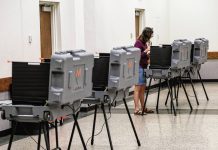Republican voters will decide May 7 whether incumbent Columbus Mayor Jim Lienhoop will be re-nominated for a second term, or whether the city will have its third consecutive new administration.
Glenn Petri, a retired industrial salesman who frequently attends city government meetings and has been a vocal critic of Lienhoop, is challenging the mayor in the GOP primary.
The winner of the May 7 primary, as of now, would be unopposed in the November general election as Democrats have not yet fielded a candidate.
Lienhoop said the desire to see some of his administration’s projects continue to develop or achieve completion in the next four years, and to continue a changed atmosphere in city government, are among his motivations for seeking a second term.
[sc:text-divider text-divider-title=”Story continues below gallery” ]
The mayor said he felt as if voters asked him to “bring a breath of fresh air to City Hall” when he defeated then-incumbent Mayor Kristen Brown in the 2015 GOP primary.
Lienhoop said he believes he’s done that and been able to recruit great people to serve in the administration the past four years.
“I feel a little sense of obligation to them to carry this on,” Lienhoop said.
Also, the mayor said he enjoys the job of mayor.
“There are parts of this job that are exceptionally rewarding,” he said, citing examples such as opportunities to work with Indiana Gov. Eric Holcomb on projects and representing Columbus at a conference on America’s role in world.
Petri said his motivation for wanting to be mayor is that he doesn’t like the way the city is being run.
“I think there’s too much wasteful spending. I don’t think the common taxpayer is getting represented very well by the city,” Petri said. “I don’t like the fact that you have to fill out a public information request for everything. They don’t make things public that the taxpayers are paying for.”
Petri said he began considering on his own a run for mayor a year ago. The decision was known only to a handful of people until he filed on the last day possible day for the primary, surprising even Brown, who he described as a friend of his.
“Some other people were supposed to run for other offices, I wanted to see what they were going to do. They did not file, so I went ahead and filed,” Petri said of his last-minute decision.
Petri said the fact that he regularly attends city meetings and sees how people vote, the issues that come up and how meetings are conducted gives him an understanding of local government and qualifies him to be mayor. He noted that he’s been attending Columbus City Council and Columbus Redevelopment Commission meetings since Fred Armstrong was mayor — three administrations ago.
“I’ve seen the best and I’ve seen the worst,” Petri said.
If elected mayor, Petri said he would seek Brown’s advice because he thinks she did a good job and represented all taxpayers, not just the special interests.
Goals of the candidates
Petri said among his primary goals would be to stop reckless spending and take care of roads.
“I think we need to make sure our roads are up to standards, not put off any kind of paving projects. We never get caught up on paving streets,” Petri said.
Petri said he’d also like to sell excess property the city owns and hasn’t developed, such as the area of Second and Lafayette streets, and use the money to improve the city.
Lienhoop said he has several priorities if he’s re-elected for another four years. The mayor said he wants to be in office when ground is broken for the railroad overpass on the city’s west side, which is intended to alleviate traffic backups cause by more trains passing through the city at higher speeds. He said 40,000 vehicles per day cross the railroad tracks at the intersection of State Roads 46 and 11 on the city’s downtown west-side entrance.
“We can’t have 40 percent of the community cut off from the other portion,” the mayor said.
Lienhoop, working to create a city partnership with Cummins Inc., the Indiana Department of Transportation and the Louisville & Indiana Railroad, helped orchestrate plans for a $30 million overpass to be built at the intersection to deal with increased train traffic traveling at higher speeds through Columbus.
INDOT has agreed to pick up half of the cost, while the city of Columbus, Bartholomew County, Cummins and the Louisville & Indiana and CSX railroads are contributing the remainder.
Last year, the city received the Accelerate Indiana Municipalities (Aim) Local Government Collaboration Award at the Aim Ideas Summit Annual Awards Luncheon for the railroad overpass collaborative effort. The awards recognized communities and individuals in municipal government for excellence and outstanding achievement.
Lienhoop also wants to continue being part of the progress being made locally to curb substance abuse, which is spearheaded by the Alliance for Substance Abuse Progress, an organization he leads along with Bartholomew County Commissioner Carl Lienhoop and Columbus Regional Health President and CEO Jim Bickel. He noted that while progress is being made by the collaborative community effort, several strategic elements still need to be implemented, such as a permanent executive director, being able to function with its own board and transitional housing.
The city also is in the early stages of redeveloping the FairOaks Mall into a year-round sports recreation and tourism complex and a possible future home for the city’s parks department.
The city purchased the nearly-empty property in December in a partnership with Columbus Regional Health, and with financial assistance from Heritage Fund — The Community Foundation of Bartholomew County, for $5.9 million total last year. The city’s share was $4 million. City officials have narrowed potential designers down to three firms who will present their ideas in public sessions May 17 and 18.
Lienhoop and other city officials also want to redevelop the riverfront area, an ongoing project for the past two years. An $8.6 million conceptual plan calls for overlooks of the East Fork White River downtown, connections to the People Trail system, an in-water recreation area and removal of the low-head dam between Second and Third streets.
“I feel a sense of responsibility to carry them (the projects) through,” the mayor said.
The railroad overpass project is one example of why voters should re-elect him, Lienhoop said.
“It’s a big deal. You talk about public-private partnerships, that won an award … To be able to bring all those folks to the table — the State of Indiana, the county of Bartholomew, the railroads, the city of Columbus — and engage an innovative use of (tax increment financing) — TIF funds that were tied to Cummins, it was a significant accomplishment, and it will alter life here in Columbus in a very positive way for the rest of time. This is the type of thing you build and it never goes away.”
Petri said efforts to bring a railroad overpass to that intersection began during the Brown administration. He said the overpass is greatly needed, though.
“That is money well spent,” Petri said.
However, Petri said that not all aspects have been finalized because one landowner has not agreed to sell a parcel of land needed for the project.
Another reason Lienhoop thinks voters should re-elect him is that city government is working well with a good work environment, the mayor said, and he treats people the way they would like to be treated. Also, the city has been able to attract talented employees with the work environment and competitive pay, thanks to the efforts of salary study which examined comparative pay rates around the state and adjusted the city pay rates accordingly.
Areas to improve
Lienhoop said he thinks the past three-and-a half years have been successful, but admitted that he has learned how critically important good, clear communication is. He said he never understood how important it is until he became mayor.
“The whole notion is to be able to explain to people what you want to do and why,” Lienhoop said.
Local residents have great interest in the community, but they need to understand the issues in order to be motivated to act, the mayor said.
“I have learned a little bit about communication and how to present that message, so I think I’ll be in a better position in the next four years to better explain to the community why we want to do what we want to do,” Lienhoop said.
Petri said that he would do some things differently if elected as mayor.
One would be to remove what he described as a “veil of secrecy that’s drawn over the city.” He noted that residents have to fill out public information requests for “all kinds of information,” and noted that he’s had three such requests pending for weeks.
“Why does it take that long?” he said.
The Lienhoop administration instituted the public information requests to keep track of the requests being made by Brown and her supporters over the past four years. In 2018, the Lienhoop administration disbanded several subcommittees after open meetings complaints were filed by Brown and others.
In October 2016, Lienhoop took the unprecedented step of reading a statement accusing Brown and some of her backers of abusing the public access process. Lienhoop said at the time that Brown and her supporters had filed more than two dozen public information requests with the city and also filed seven complaints with Indiana Public Access Counselor Luke Britt.
The lion’s share of the complaints came from Brown, local resident Ken Fudge and David Jones, who had previously been appointed by Brown to serve on the Columbus Park Board.
“The cost to those who complain and object is next to zero,” Lienhoop said in 2016 in a statement read in a public meeting. “The cumulative cost to our city to respond to these is in the thousands of dollars.”
Petri said the $1.5 million the city has spent so far on the plans for the riverfront project is an example of wasteful spending because of the problems the Department of Natural Resources has raised with the proposed plan.
“I don’t need a major project to stamp my name on the city or anything. There’s plenty of minor things you can go into local neighborhoods and take care of,” Petri said. “And at the end of my term I’d like people to say, ‘Hey, at least he took care of my neighborhood.’”
[sc:pullout-title pullout-title=”The Petri file” ][sc:pullout-text-begin]
Glenn Petri
Age: 69
Current occupation: Retired from industrial sales
Education: Bachelor of arts in social sciences, urban planning at Southern Illinois University
Previous elected offices held (and when): None
Community organization memberships and service: Past member of Columbus Downtown Inc., time keeper for Southside basketball, board member of Columbus Area Railroad Club.
Family: Widower, two adult children, two grandchildren
[sc:pullout-text-end][sc:pullout-title pullout-title=”The Lienhoop file” ][sc:pullout-text-begin]
Jim Lienhoop
Age: 65
Current occupation: Mayor of Columbus
Education: Bachelor of science in business, accounting from Indiana University
Previous elected offices held (and when): Columbus City Council, selected to fill in for a council member called to active duty for nine months in 2006 and again for 2008 to 2011. Elected as an at-large member of Columbus City Council for the years 2012 to 2015. Elected mayor for the years 2016 to present.
Community organization memberships and service: St. Peter’s Lutheran Church; certified public accountant (inactive); Accelerate Indiana Municipalities, Finance Committee chairman; Administrative Resources Association, president; Alliance for Substance Abuse Progress-Bartholomew County, board member; Ball State University-Indiana Communities Institute, Silver Certificate; Bartholomew County Solid Waste Management District, board member; CEO’s for Cities, speaker; Columbus Area Chamber of Commerce, board member; Community Education Coalition, board member; FairOaks Community Development Corporation, president; Greater Columbus Economic Development Corp., board member; Heritage Fund – The Community Foundation of Bartholomew County, board member; Indiana University School of Public and Environmental Affairs, speaker; IUPUC Advisory Board, member; National League of Cities, speaker; Olympic Quarterback Club, co-founder; Rotary, Paul Harris Fellow; U.S. Conference of Mayors.
Family: Wife, Pam; two adult children, a son and a daughter
[sc:pullout-text-end][sc:pullout-title pullout-title=”Coming next Sunday” ][sc:pullout-text-begin]
The Republic’s second of three stories about the mayor’s race in the primary will focus on major projects the person elected mayor will lead during the next four years. See the April 21 edition for details.
The final installment, on April 28, will focus on other important issues in the community the mayor will have a hand in.
[sc:pullout-text-end][sc:pullout-title pullout-title=”Early voting” ][sc:pullout-text-begin]
The primary is May 7.
Early voting continues at the Bartholomew County Courthouse in downtown Columbus.
Voters who live in the city may cast their ballots in person at the courthouse until May 3 from 8 a.m. to 5 p.m. The courthouse will be open for early voting on two Saturdays – April 27 and May 4 – from 8 a.m. to 3 p.m.
Early voting is also available at Donner Center, at 739 22nd Street, from April 29 to May 3 from 10 a.m. to 6 p.m. and on Saturday, May 4 from 8 a.m. to 3 p.m.
[sc:pullout-text-end]




